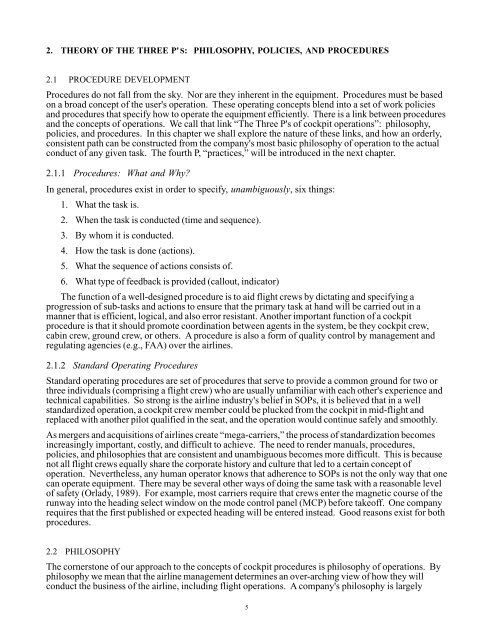On the Design of Flight-Deck Procedures - Intelligent Systems ...
On the Design of Flight-Deck Procedures - Intelligent Systems ...
On the Design of Flight-Deck Procedures - Intelligent Systems ...
Create successful ePaper yourself
Turn your PDF publications into a flip-book with our unique Google optimized e-Paper software.
2. THEORY OF THE THREE P'S: PHILOSOPHY, POLICIES, AND PROCEDURES2.1 PROCEDURE DEVELOPMENT<strong>Procedures</strong> do not fall from <strong>the</strong> sky. Nor are <strong>the</strong>y inherent in <strong>the</strong> equipment. <strong>Procedures</strong> must be basedon a broad concept <strong>of</strong> <strong>the</strong> user's operation. These operating concepts blend into a set <strong>of</strong> work policiesand procedures that specify how to operate <strong>the</strong> equipment efficiently. There is a link between proceduresand <strong>the</strong> concepts <strong>of</strong> operations. We call that link “The Three P's <strong>of</strong> cockpit operations”: philosophy,policies, and procedures. In this chapter we shall explore <strong>the</strong> nature <strong>of</strong> <strong>the</strong>se links, and how an orderly,consistent path can be constructed from <strong>the</strong> company's most basic philosophy <strong>of</strong> operation to <strong>the</strong> actualconduct <strong>of</strong> any given task. The fourth P, “practices,” will be introduced in <strong>the</strong> next chapter.2.1.1 <strong>Procedures</strong>: What and Why?In general, procedures exist in order to specify, unambiguously, six things:1. What <strong>the</strong> task is.2. When <strong>the</strong> task is conducted (time and sequence).3. By whom it is conducted.4. How <strong>the</strong> task is done (actions).5. What <strong>the</strong> sequence <strong>of</strong> actions consists <strong>of</strong>.6. What type <strong>of</strong> feedback is provided (callout, indicator)The function <strong>of</strong> a well-designed procedure is to aid flight crews by dictating and specifying aprogression <strong>of</strong> sub-tasks and actions to ensure that <strong>the</strong> primary task at hand will be carried out in amanner that is efficient, logical, and also error resistant. Ano<strong>the</strong>r important function <strong>of</strong> a cockpitprocedure is that it should promote coordination between agents in <strong>the</strong> system, be <strong>the</strong>y cockpit crew,cabin crew, ground crew, or o<strong>the</strong>rs. A procedure is also a form <strong>of</strong> quality control by management andregulating agencies (e.g., FAA) over <strong>the</strong> airlines.2.1.2 Standard Operating <strong>Procedures</strong>Standard operating procedures are set <strong>of</strong> procedures that serve to provide a common ground for two orthree individuals (comprising a flight crew) who are usually unfamiliar with each o<strong>the</strong>r's experience andtechnical capabilities. So strong is <strong>the</strong> airline industry's belief in SOPs, it is believed that in a wellstandardized operation, a cockpit crew member could be plucked from <strong>the</strong> cockpit in mid-flight andreplaced with ano<strong>the</strong>r pilot qualified in <strong>the</strong> seat, and <strong>the</strong> operation would continue safely and smoothly.As mergers and acquisitions <strong>of</strong> airlines create “mega-carriers,” <strong>the</strong> process <strong>of</strong> standardization becomesincreasingly important, costly, and difficult to achieve. The need to render manuals, procedures,policies, and philosophies that are consistent and unambiguous becomes more difficult. This is becausenot all flight crews equally share <strong>the</strong> corporate history and culture that led to a certain concept <strong>of</strong>operation. Never<strong>the</strong>less, any human operator knows that adherence to SOPs is not <strong>the</strong> only way that onecan operate equipment. There may be several o<strong>the</strong>r ways <strong>of</strong> doing <strong>the</strong> same task with a reasonable level<strong>of</strong> safety (Orlady, 1989). For example, most carriers require that crews enter <strong>the</strong> magnetic course <strong>of</strong> <strong>the</strong>runway into <strong>the</strong> heading select window on <strong>the</strong> mode control panel (MCP) before take<strong>of</strong>f. <strong>On</strong>e companyrequires that <strong>the</strong> first published or expected heading will be entered instead. Good reasons exist for bothprocedures.2.2 PHILOSOPHYThe cornerstone <strong>of</strong> our approach to <strong>the</strong> concepts <strong>of</strong> cockpit procedures is philosophy <strong>of</strong> operations. Byphilosophy we mean that <strong>the</strong> airline management determines an over-arching view <strong>of</strong> how <strong>the</strong>y willconduct <strong>the</strong> business <strong>of</strong> <strong>the</strong> airline, including flight operations. A company's philosophy is largely5
















